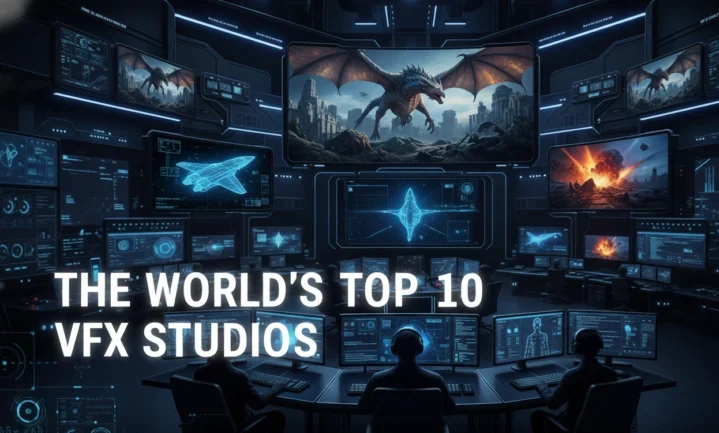The Top 10 Global VFX Production Partners for Entertainment Executives

Introduction
The demand for hyper-realistic visual effects (VFX) in film, television, and streaming content has transformed VFX houses from mere post-production vendors into essential creative and technological VFX production partners.
In a market where visual quality is directly tied to audience acquisition and retention, the strategic selection of a service provider has become a critical business decision. Yet, the global entertainment supply chain is fragmented, making it difficult for senior executives to conduct rapid, objective due diligence on a studio’s true capabilities, pipeline scale, and financial standing.
The challenge is not just finding a studio but vetting a partner whose technical proficiency and stability match the needs of a multi-million-dollar production. This guide is structured to address this strategic procurement problem, providing an executive framework for evaluation and featuring a curated list of top-tier VFX and content entities currently driving global production.
Table of content
- Setting the Stage: The Strategic Market for VFX Partnerships
- Our Evaluation Framework: Vetting VFX Production Partners
- The Top VFX Production Partners and Content Companies
- How to Integrate These Partners into Your Production Pipeline
- How Vitrina Helps Streamline Partner Discovery
- Conclusion
- Frequently Asked Questions
Key Takeaways
| Core Challenge | Fragmented global data limits the ability to objectively vet and procure reliable, high-scale VFX partners for major film and TV projects. |
| Strategic Solution | Employ a data-driven framework focused on technical specialization, geographical footprint, and financial stability when selecting a VFX partner. |
| Vitrina’s Role | Vitrina tracks the global entertainment supply chain, providing verified project, collaboration, and executive data to streamline the partner vetting process. |
Setting the Stage: The Strategic Market for VFX Partnerships
The Visual Effects (VFX) market is undergoing a rapid technological and commercial expansion, making partner selection more complex and higher-stakes than ever. According to market analysis, the global VFX market, valued at approximately $25.63 billion in 2025, is projected to reach $57.95 billion by 2035, exhibiting a robust Compound Annual Growth Rate (CAGR) of 8.5% between 2026 and 2035, as reported by Research Nester.
This growth is fundamentally driven by the consumption habits of global audiences: approximately 78% of blockbuster films and 62% of Over-The-Top (OTT) originals now rely on substantial VFX integration, according to a 2025 report from Global Growth Insights.
The demand surge from global streaming platforms, which are constantly investing in high-budget original content, is a primary growth driver. This has accelerated the need for scalable, high-quality VFX production partners capable of handling large-volume, fast-turnaround projects.
Geographically, North America remains the largest market, expected to hold around a 45% share by 2035 due to the concentration of major Hollywood studios; however, the Asia-Pacific (APAC) region is recognized as the fastest-growing market, driven by content demand and the rise of skilled, outsourced post-production hubs. Technologically, the industry is pivoting toward real-time workflows.
The integration of Artificial Intelligence (AI) and machine learning tools is set to dominate, with the AI segment in the VFX market projected to achieve a 75.2% share by 2035, boosting efficiency in tasks like rotoscoping and environmental generation, as detailed by Research Nester.
Selecting a partner today means assessing their readiness and investment in these next-generation production technologies. Without this strategic outlook, executives risk committing to partners whose pipelines will quickly become outdated.
Our Evaluation Framework: Vetting VFX Production Partners
Selecting an appropriate VFX studio requires a strategic, multi-faceted evaluation that moves beyond reviewing a highlight reel. The following framework represents the core criteria an executive must use to assess the viability and reliability of a potential partner.
- Technical Specialization and Pipeline Readiness: The modern VFX workflow is increasingly specialized. Executives must assess if a studio’s primary expertise—whether it’s high-fidelity creature work, photo-realistic environmental creation, or volume-based virtual production—aligns precisely with the project’s demands. Crucially, a top-tier partner must demonstrate fluency in next-generation tools like Unreal Engine, Nuke, and Houdini, showing they are prepared for real-time collaboration and cloud-based workflows.
- Scalability and Global Footprint: Given the high volume of content production, a partner must prove they can scale their teams quickly to meet non-negotiable delivery schedules. This involves evaluating the size of their talent pool, the capacity of their render farm infrastructure, and their ability to execute distributed, cross-border workflows. Studios with established facilities in rapidly growing regions like APAC or those that offer favorable tax incentives often provide strategic financial advantages.
- Financial Stability and IP Security: The history of the entertainment industry is littered with VFX houses that collapse mid-production, jeopardizing film releases. Due diligence must include verifying the company’s financial track record and stability. Furthermore, security protocols—from on-set data acquisition to server-side IP protection and clear Non-Disclosure Agreement (NDA) compliance—are non-negotiable criteria for working with high-value content.
The Top VFX Production Partners and Content Companies
The following list comprises a mix of specialized VFX service providers and major content production/broadcasting entities that serve as vital links in the global media supply chain. Their roles range from providing niche post-production services to acting as the primary distribution channels for content requiring high-quality visual effects. The companies are presented here in the user-provided order:
- AB VFX Studios
AB VFX Studios operates as a dedicated service provider within the post-production sector, specializing in the complex visual effects requirements for film and television. The studio focuses on delivering essential services such as compositing, roto, and cleanup, supporting a wide array of content creators globally. - TOP The Oligarchs Productions
TOP The Oligarchs Productions functions as a content-focused entity, often engaging in or commissioning high-end projects that necessitate robust visual effects and animation integration. Its operations involve managing production logistics and securing talent for projects across various media formats. - Network 10
As a major Australian commercial free-to-air television network, Network 10, a subsidiary of Paramount Global, is a significant commissioner and broadcaster of content. The network’s portfolio—which includes drama, reality, and sports—drives substantial demand for third-party production and VFX services across Australia. - Genesis Animation VFX Studios
Genesis Animation VFX Studios is positioned as a comprehensive creative studio offering both animation and visual effects services to the global entertainment industry. The firm works to blend complex 3D modeling and animation techniques with detailed VFX compositing for feature-length and series projects. - VFX Studio
VFX Studio serves as a general visual effects house providing a range of digital services essential to modern film and television post-production. The company provides necessary technical support for directors and producers, handling tasks from concept visualization through final rendering. - VFX PICK
VFX PICK is recognized as a top VFX studio in India with a strong international client base, specializing in essential services like rotoscoping, paint and cleanup, compositing, and matchmove/camera tracking. The firm is actively investing in continuous R&D, including the adoption of AI-aided rotoscoping and virtual production techniques, according to its internal communications. - Saeta TV Canal 10
Saeta TV Canal 10 is a long-established, prominent private television channel in Uruguay, serving as a key broadcaster in the Latin American market. As a major content distributor, the company is a primary buyer and producer of programming that often requires regional post-production and visual effects work. - Chromatic VFX
Chromatic VFX is a creative service vendor focused on providing specialized visual effects and digital post-production solutions for various media platforms. The company concentrates on color grading, compositing, and visual integration to enhance the final cinematic quality of feature films and television series. - RPM VFX
RPM VFX specializes in detailed VFX outsourcing services, including high-demand processes like Roto, Paint, Matchmove, and advanced digital cosmetic work such as De-Ageing and Beautification. The studio emphasizes a collaborative, client-focused methodology and aims to establish a global network of specialized teams for high-quality imagery. - Top Film CIS
Top Film CIS operates as a production and distribution company primarily focused on the Commonwealth of Independent States (CIS) region. The company is involved in packaging and financing content, often necessitating the selection of local and international service vendors for post-production and CGI requirements.
How to Integrate These Partners into Your Production Pipeline
Integrating a third-party VFX studio effectively requires a structured procurement and collaboration strategy. The primary goal is to mitigate risk and ensure technical and creative alignment from the initial stages of development.
- Standardize the Technical Due Diligence: Before issuing a formal Request for Proposal (RFP), demand a technical compatibility review. This includes a clear audit of their production pipeline to ensure seamless integration with your on-set data capture, editorial, and grading workflows. Crucially, ask for a demonstration of their data security protocols and their disaster recovery plan, especially for cloud-based or geographically distributed pipelines. This due diligence must also verify their proficiency with specific industry software and next-generation tools, a factor that ensures long-term operational viability.
- Establish a Centralized Data Source of Truth: A common pain point is the fragmented nature of creative data—from shot lists and asset versions to artist notes and contractual terms. Implement a unified, cloud-based platform for all project tracking, shot versioning, and client feedback. A system that can connect the internal production team with the outsourced VFX studio in real-time is essential to preventing costly miscommunications and revisions late in the post-production cycle.
- Define the Collaboration and Delivery Metrics: Move beyond simple delivery deadlines by establishing clear Quality Control (QC) metrics at every milestone. This includes defining the acceptable percentage of artifacts, keying accuracy standards, and the required turnaround time for iterative feedback loops. The contract should mandate the assignment of a dedicated VFX Producer from the studio whose role is to act as the single point of contact, ensuring executive-level accountability and efficient resource allocation.
How Vitrina Helps Streamline Partner Discovery
Vitrina addresses the core challenge of fragmented data in the entertainment supply chain by providing a centralized platform for partner scouting and due diligence.
The platform tracks over 3,000,000 film and TV projects and profiles major vendors, including the VFX production partners listed above. For an executive seeking to vet a global studio, Vitrina provides verified information on their collaboration history, project track record across various genres, and detailed metadata on their specialization (e.g., rotoscoping, CG environments, virtual production).
This capability replaces inefficient manual scouting with a structured, data-driven approach, allowing you to quickly identify co-production partners, distribution entities, or specialized VFX houses that match your project’s precise needs and budget requirements.
Conclusion
The strategic selection of VFX production partners is a primary lever for managing budget, quality, and schedule risk in modern film and television production.
As the industry scales toward real-time workflows and greater reliance on AI-driven tools, the ability to objectively vet a partner’s technical readiness and financial reliability is a strategic advantage.
By implementing a rigorous evaluation framework—one that prioritizes specialization, global scale, and proven pipeline integration—executives can transform the outsourcing process from a procurement headache into a confident, data-backed partnership.
Frequently Asked Questions
The global visual effects (VFX) market is projected to reach $57.95 billion by 2035, growing at an estimated Compound Annual Growth Rate (CAGR) of 8.5% between 2026 and 2035, according to Research Nester.
Demand is primarily driven by the proliferation of streaming platforms investing heavily in original, high-quality content, alongside the continued reliance of blockbuster films (up to 78%) on complex visual effects to enhance storytelling.
The integration of Artificial Intelligence (AI) is crucial for efficiency, with the AI segment in the VFX market projected to achieve a 75.2% share by 2035. AI-driven tools are used to accelerate tasks like rotoscoping, compositing, and quality control.
Regional outsourcing, particularly to the Asia-Pacific market, is a significant trend driven by the availability of a skilled workforce and favorable production costs, enabling global studios to scale their VFX capacity and reduce production time.

























